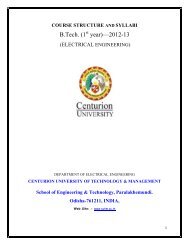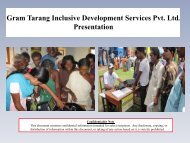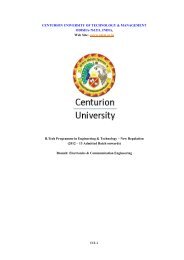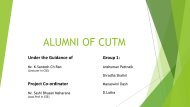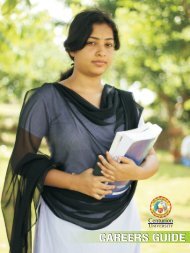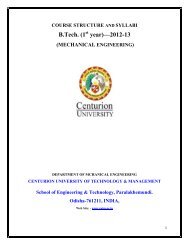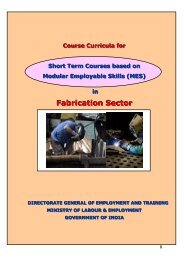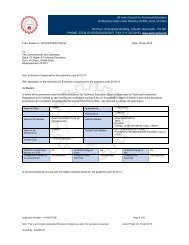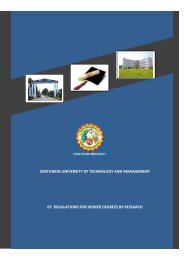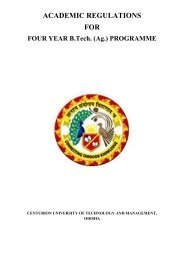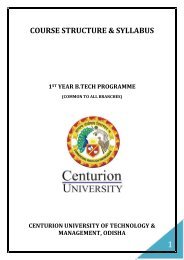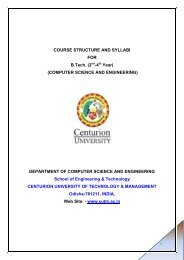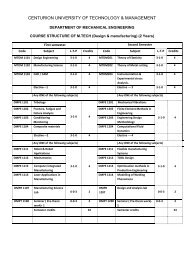1st Year CSE - Cutm.ac.in
1st Year CSE - Cutm.ac.in
1st Year CSE - Cutm.ac.in
Create successful ePaper yourself
Turn your PDF publications into a flip-book with our unique Google optimized e-Paper software.
1 ST SEMESTERBTMA 1101 MATHEMATICS-I (3-1-0)MODULE-I (15 Hours)First Order Differential Equations: Separable Equations, Homogeneous & Non- homogeneous Equations,Ex<strong>ac</strong>t Differential Equations, Integrat<strong>in</strong>g F<strong>ac</strong>tor, L<strong>in</strong>ear Differential Equations, Bernoulli Equation.MODULE-II (15 Hours)Second & Higher Order L<strong>in</strong>ear Differential Equations: L<strong>in</strong>ear Dependence and Independence ofSolutions, Wronskian, Constant Coefficient Homogeneous Equations, Cauchy-Euler Equation, NonhomogeneousEquations, Method of Variation of Parameter, Method of Inverse Operator, LegendreEquation.MODULE-III (20 Hours)L<strong>in</strong>ear Algebra, Basic Concepts, L<strong>in</strong>ear System of Equations, Solution by Gauss Elim<strong>in</strong>ation, Conditionsof Existence and Uniqueness of Solutions, Rank of a Matrix, Determ<strong>in</strong>ants and Cramer’s Rule, L<strong>in</strong>earDependence and Independence, Eigen Values and Eigen Vectors, Basis, Symmetric, Skew-Symmetricand Orthogonal Matrices, Complex Matrices, Similarity of Matrices, Diagonalization.Text Books:1) Higher Eng<strong>in</strong>eer<strong>in</strong>g Mathematics by B.V. RamanPublisher: TMHChapters : 8 (8.1 to 8.10) ; 9 (9.1 to 9.7)2) Advanced Eng<strong>in</strong>eer<strong>in</strong>g Mathematics by E. KreyszigPublisher: Johnwilley & Sons Inc-8 th EditionChapters : 6 (6.1 to 6.6) ; 7 (7.1, 7.3 to 7.5)Reference Books:1) Advanced Eng<strong>in</strong>eer<strong>in</strong>g Mathematics by P.V.O’ NeilPublisher: Thomson2) Mathematical Methods by Potter & Goldberg ; Publisher : PHI3
BTHU 1102 ENGLISH FOR COMMUNICATION (2-0-0)English is used as an important tool or catalyst <strong>in</strong> the career of students.OBJECTIVESThis is a pr<strong>ac</strong>tice-oriented, need-based, functional- communicative course designed to <strong>ac</strong>hieve specificl<strong>in</strong>guistic and communicative competence <strong>in</strong> order for them to <strong>ac</strong>quire relevant skills and functionefficiently <strong>in</strong> a realistic work<strong>in</strong>g context. The student is advised to cultivate the habit of read<strong>in</strong>gnewspapers, magaz<strong>in</strong>es, novels and books <strong>in</strong> a free, extensive manner to consolidate the skills already<strong>ac</strong>hieved. This implies emphasis on “do<strong>in</strong>g”. A more <strong>in</strong>ter<strong>ac</strong>tive process of te<strong>ac</strong>h<strong>in</strong>g/ learn<strong>in</strong>g is calledfor to <strong>ac</strong>hieve the skills of effective communication.MODULE I: IMPORTANCE OF COMMUNICATION(8 Hours)1. Basics of Communication: Process of Communication and f<strong>ac</strong>tors that <strong>in</strong>fluencecommunication – Sender, receiver, channel, code, topic, message, context, feedb<strong>ac</strong>k,noise, filters and barriers2. Audience and Purpose3. Verbal and Non-verbal Communication4. Pla<strong>in</strong> English5. Formal and Informal Style: Degrees of formality6. Guidel<strong>in</strong>es for Effective Communication: Seven C’s of Communication(In this module we will discuss the importance of English language skills <strong>in</strong> a variety of contexts. This<strong>in</strong>ter<strong>ac</strong>tive class will provide the students with the knowledge necessary to beg<strong>in</strong> to identify anddescribe communicative events <strong>in</strong> their lives, analyze them, and make choices about mean<strong>in</strong>gs andresponses <strong>in</strong> appropriate and effective ways.)MODULE II: COMMUNICATIVE GRAMMAR1. Time, Tense and Aspect2. Verbs of States and Events3. Modals4. Conditionals5. Active and Passive Voice6. Statements, Questions and Responses7. Articles and Prepositions8. Concord9. Phrasal Verbs(8 Hours)(* The te<strong>ac</strong>h<strong>in</strong>g of grammar should be treated as a diagnostic and remedial <strong>ac</strong>tivity and <strong>in</strong>tegrated withcommunication pr<strong>ac</strong>tice. The areas of grammar <strong>in</strong> which errors are common should receive specialattention when select<strong>in</strong>g items for review.)MODULE III: THE SOUNDS OF ENGLISH(8 Hours)4
1. Vowels: Pure vowels and glid<strong>in</strong>g vowels2. Consonants and Consonant Clusters3. Syllables and Stress Pattern <strong>in</strong> sentences4. Intonation(* This module should be taught <strong>in</strong> a simple, non-technical manner, avoid<strong>in</strong>g technical terms as far aspossible.)MODULE IV: ENGLISH VOCABULARY(6 Hours)1. One Word Substitution2. Word Formation3. Synonyms, Antonyms and Homonyms(*Treatment: Word games/ clusters, cross words, puzzles, one word completions, rapid fire questions(quiz), word usage, f<strong>in</strong>d<strong>in</strong>g words closest <strong>in</strong> mean<strong>in</strong>g, pr<strong>ac</strong>tice exercises and discussions)BOOKS RECOMMENDED1. Effective Technical Communication, M. Ashraf Rizvi, TMH Publications.2. Bus<strong>in</strong>ess Communication Today, Courtland L Bovee, John V Thill & Mukesh Chaturvedi, PearsonEducation.3. Geoffrey Leech and Jan Svartvik, Longman, A communicative Grammar of English.4. J.D. O’Connor, Better English Pronunciation, Cambridge University Publication.5. An Introduction to Professional English and soft skills by B.K Das et al., Cambridge UniversityPress6. Bus<strong>in</strong>ess Communication, Urmila Rai & S.M Rai, Himalaya Publish<strong>in</strong>g House7. Bus<strong>in</strong>ess communication by Meenakshi Raman and Prakash S<strong>in</strong>gh(Oxford)8. Communication Skills, Leena Sen, Prentice Hall of India, 20089. Word Power Made Easy, Norman LewisModule- I (18 hours)BTPH 1203 ENGINEERING PHYSICS (3-1-0)Electrical and Electronic materials: Electrical conductivity, Thermal conductivity, Free electron theory,Energy band concept of conductor, <strong>in</strong>sulator & semiconductor. Intr<strong>in</strong>sic and extr<strong>in</strong>sic semiconductors,Hall Effect.Superconductor materials: Pr<strong>in</strong>ciples of superconductivity, zero resistivity, Critical magnetic field andcritical current density, Type I & II superconductors, BCS theory, Meissner effect, Isotope effect,Applications of superconductorsModule-II (16 hours)Optical materials: optical properties – scatter<strong>in</strong>g, refr<strong>ac</strong>tion, reflection, transmission & absorption5
Laser: Introduction, pr<strong>in</strong>ciple of Laser, stimulated and spontaneous emission, Ruby Laser, Application ofLasers.Fibre Optics: Introduction, numerical aperture, step <strong>in</strong>dex and graded <strong>in</strong>dex fibres, attenuation &dispersion mechanism <strong>in</strong> optical fibers (Qualitative only), application of optical fibres, opticalcommunication (block diagram only)Module-III (16 hours)ElectromagnetismVector calculus: gradient of scalar field, divergence, curl of vector field (only Physical significance), Gaussdivergence theorem, Stoke’s theorem, Green’s theorem (only statements)Gauss’s law of electrostatics <strong>in</strong> free sp<strong>ac</strong>e and <strong>in</strong> a medium(Only statements), electric displ<strong>ac</strong>ement( D)magnetic Induction (B), Amperes circuital law(Only statements), displ<strong>ac</strong>ement current, Faraday’s law ofelectromagnetic <strong>in</strong>duction(Only statements).Maxwell’s electromagnetic equation <strong>in</strong> differential form and <strong>in</strong> <strong>in</strong>tegral form (Only statements).Electromagnetic energy density, Poynt<strong>in</strong>g vector, Poynt<strong>in</strong>g theorem, vector potential and scalar potential,electromagnetic wave equation for E and B, transverse nature of EM waves.Text Books:1. Eng<strong>in</strong>eer<strong>in</strong>g Physics by D.R. Joshi, McGraw Hill (Third repr<strong>in</strong>t 2010)2. Eng<strong>in</strong>eer<strong>in</strong>g Physics by H.K. Malik and A.K. S<strong>in</strong>gh, McGraw Hill. (First edition 2010)3. Material Science by M S Vijaya & G Rangarajan, McGraw HillReference Books:1. Material Science for Eng<strong>in</strong>eers by James F. Sh<strong>ac</strong>helford & Madanapalli K. Muralidhara, Pearson2. Callister’s Materials Science and Eng<strong>in</strong>eer<strong>in</strong>g, Wiley India (P) Ltd.3. Physics for Eng<strong>in</strong>eers-I: Dr. S. N. Jena & H. R. Pattnaik (First edition 2009)BTCS 1107 Fundamentals of Computer (3-1-0)Module 1(20 hours)Computer Basics: A simple model of computers, Digital and Analog Computers, Evolution of digitalcomputers, Major Components of a digital computer, hardware, software, firmware, middleware, freeware.Input/output Devices: Input Devices, Output Devices, Pr<strong>in</strong>ters, and Plotters, Other forms of Outputdevices, Input and Output port.Number System: Decimal Number System, B<strong>in</strong>ary Number System, conversion of numbers(b<strong>in</strong>ary todecimal, decimal to b<strong>in</strong>ary), Addition of B<strong>in</strong>ary Numbers, 1’s complement and 2’s complementrepresentation of numbers, B<strong>in</strong>ary Subtr<strong>ac</strong>tion, B<strong>in</strong>ary Multiplication, B<strong>in</strong>ary Division, Hexadecimal and6
octal number system, ASCII and ISCII code, EBCDIC code, Gray codes, Fixed po<strong>in</strong>t and Float<strong>in</strong>g Po<strong>in</strong>tRepresentation, Overflow and Underflow.Logic Circuits: Switch<strong>in</strong>g circuits, AND/OR operations, NOT operations, Boolean Functions, CanonicalForms of Boolean Functions, Logic circuits.Module 2(12 hours)Processor: CPU organization, Structure of Instruction, A m<strong>ac</strong>h<strong>in</strong>e level languageComputer Memory: Read only memory, Serial Access memory, Ma<strong>in</strong> memory, Secondary memory:Magnetic hard disk, Floppy disk Drives, Comp<strong>ac</strong>t Disk Read Only memory, Magnetic tape Drives.Computer Architecture: Interconnection of units, Processor to memory communication, I/O to processorcommunication, Interrupt Structure, Multiprogramm<strong>in</strong>g, Processor Features, RISC, Virtual Memory.Module 3(18 hours)Computer Languages: Programm<strong>in</strong>g Language, Introduction to Interpreter and compiler, AssemblyLanguage, Higher Level LanguagesOperat<strong>in</strong>g System: Need of an OS, Batch operat<strong>in</strong>g system, multiprogramm<strong>in</strong>g Operat<strong>in</strong>g system, Timeshar<strong>in</strong>g Operat<strong>in</strong>g System, personal computer Operat<strong>in</strong>g system, on-l<strong>in</strong>e and real time system.Computers and Communications: Computer Generations, Types of communications with and amongcomputers, <strong>in</strong>ternet and world wide web, char<strong>ac</strong>teristics of communication channels, PhysicalCommunication Model, Computer Network topologies, Local Area Network.Text Book:1. Fundamentals of Computers, by V.Rajaraman(chapter 1,2,3,4,5,6,7,8,9,10,12,13)2. Reference Books:1. Computer Fundamentals, by B.Ram2. Computer Fundamentals by P.K.S<strong>in</strong>haModule I: (18 Hours)BTCS 1106 ‘C’ <strong>in</strong> Use (3-1-0)Problem solv<strong>in</strong>g techniques: Algorithm, flow chart; Structure of C program, Char<strong>ac</strong>ter set, Identifiers,Keywords, Data Types, Constants and Variables, Input-output statements, relational and logicaloperators, <strong>in</strong>crement and decrement operators, conditional operator, bit-wise operators, assignmentoperators, expressions, type conversions, conditional expressions, precedence and order of evaluation,statements and blocks, if and switch statements, loops:-while, do-while and for statements, break,cont<strong>in</strong>ue, goto.Module II: (18 Hours)7
Arrays- concepts, declaration, def<strong>in</strong>ition, <strong>ac</strong>cess<strong>in</strong>g elements, two-dimensional and multi-dimensionalarrays, applications of arrays. Design<strong>in</strong>g structured programs:-Functions, parameter pass<strong>in</strong>g, userdef<strong>in</strong>ed functions, recursive functions, storage classes- extern, auto, register, static, scope rules. po<strong>in</strong>tersconcepts,<strong>in</strong>itialization of po<strong>in</strong>ter variables, po<strong>in</strong>ters and function arguments, address arithmetic,Char<strong>ac</strong>ter po<strong>in</strong>ters and functions, po<strong>in</strong>ters to po<strong>in</strong>ters, po<strong>in</strong>ters and multidimensional arrays, dynamicmemory management functions, command l<strong>in</strong>e arguments.Module III: (14 Hours)Derived types- structures- declaration, def<strong>in</strong>ition and <strong>in</strong>itialization of structures, <strong>ac</strong>cess<strong>in</strong>g structures,nested structures, arrays of structures, structures and functions, po<strong>in</strong>ters to structures, self referentialstructures, unions, typedef, bit fields, C program examples. Input and output – concept of a file, text filesand b<strong>in</strong>ary files, streams, standard I/O, Formatted I/O, file I/O operations, error handl<strong>in</strong>g, C programexamples.Text Books:1. E. Balaguruswamy “Programm<strong>in</strong>g <strong>in</strong> C”, Tata McGraw Hill-3rd edition2. Y. Kanetkar, “Let us C”, BPB Publications-9th edition.Reference:1. H. Scheldt, “C The Complete Reference”, Tata McGraw Hill2. B.W. Kernighan & D.M. Ritchie, "C Programm<strong>in</strong>g Language", PHI.3. Schaum Series- “C Programm<strong>in</strong>g” - GotterfriedBLHU 1112 COMMUNICATIVE PRACTICE LAB –I (0-0-3)The language lab <strong>ac</strong>ts as a platform for learn<strong>in</strong>g, pr<strong>ac</strong>tic<strong>in</strong>g and produc<strong>in</strong>g language skills through<strong>in</strong>ter<strong>ac</strong>tive lessons and communicative mode of te<strong>ac</strong>h<strong>in</strong>g. It aimsTo expose the students to a variety of self- <strong>in</strong>structional, learner- friendly modes of languagelearn<strong>in</strong>g.To enable them to learn better pronunciation through stress on word <strong>ac</strong>cent, <strong>in</strong>tonation, andrhythmTo ma<strong>in</strong>ta<strong>in</strong> good l<strong>in</strong>guistic - through <strong>ac</strong>cur<strong>ac</strong>y <strong>in</strong> grammar, pronunciation and vocabularyA student is required to take up five lab tests of 100 marks- three tests <strong>in</strong> spoken mode and two tests <strong>in</strong>written mode.The suggestive assignments <strong>in</strong> the lab are <strong>in</strong>tended as learn<strong>in</strong>g <strong>ac</strong>tivities to assist the student <strong>in</strong><strong>ac</strong>complish<strong>in</strong>g the course objectives:I. FRIENDLY COMMUNICATION: 9 HOURSa) Do<strong>in</strong>g Th<strong>in</strong>gs with Words: To ask for <strong>in</strong>formation, help, permission; To <strong>in</strong>struct, command,request, <strong>ac</strong>cept, refuse, prohibit, persuade8
) Pr<strong>ac</strong>tice of Formulaic Expressions: Greet<strong>in</strong>gs, farewells, <strong>in</strong>troductions, thanks, apologies, regrets,good wishes, congratulations, condolences, offers.c) Conversation Pr<strong>ac</strong>tice <strong>in</strong> familiar and unfamiliar situationsII. GRAMMAR AND VOCABULARY9 HOURSThe focus will be on the appropriate usage of language.a) Elim<strong>in</strong>ation of common errorsb) Edit<strong>in</strong>g passagesc) Word power A-Z: Easy and quick techniquesd) Vocabulary build<strong>in</strong>g exercisesIII.PHONETICS AND SPOKEN ENGLISH12 HOURSStudents will be tra<strong>in</strong>ed to f<strong>in</strong>d out the correct pronunciation of words with the help of adictionary /software, to enable them to monitor and correct their own pronunciation.a)Pronunciation Guidel<strong>in</strong>es: Consonants and VowelsPronunciation pr<strong>ac</strong>tice (for <strong>ac</strong>cent neutralization), particularly of problem sounds, <strong>in</strong>isolated words as well as sentencesb) Speak<strong>in</strong>g Techniques: Us<strong>in</strong>g correct stress patterns, develop<strong>in</strong>g voice qualityc) Rhythm and Intonation(Read<strong>in</strong>g aloud of dialogues, speeches etc. for pr<strong>ac</strong>tice <strong>in</strong> pronunciation)BLPH 1210 ENGINEERING PHYSICS LABORATORY (0-0-3)Student is expected to perform twelve experiments from the list given below.1. Determ<strong>in</strong>ation of <strong>ac</strong>celeration due to gravity by Bar / Kater’s pendulum.2. Determ<strong>in</strong>ation of thermal conductivity by Lee’s method.3. Plott<strong>in</strong>g of char<strong>ac</strong>teristic curves of a PN junction diode.4. Plott<strong>in</strong>g of char<strong>ac</strong>teristic curves of BJT.5. Study of Hall Effect.6. Study of resonance <strong>in</strong> LCR circuit and damp<strong>in</strong>g effect.7. Study of a power source- output impedance.8. Study of a Photoemission.9. Measurement of resistivity of semiconductor by four probe method and determ<strong>in</strong>ation of bandgap.10. Study of electromagnetic damp<strong>in</strong>g of a compound pendulum and to f<strong>in</strong>d the variation of damp<strong>in</strong>gcoefficient with the distance of conduct<strong>in</strong>g lam<strong>in</strong>a.11. Determ<strong>in</strong>ation of wavelength of LASER source by diffr<strong>ac</strong>tion grat<strong>in</strong>g method.12. Measurement of attenuation and bend<strong>in</strong>g losses of an optical fibre.9
13. Measurement of numerical aperture of an optical fibre.14. Study of spatial and temporal coherence of LASER.15. Measurement of Temperature coefficient of resistance.BLCS 1115 Personal Computer Workshop (0-0-3)Experiment 1: Introduction to computer and connectivity of different functional units.Experiment 2: Identification of various components of a computer and its functions.Experiment 3: Identification of various power supply units and peripheral units and their functions.Experiment 4: Hardware Troubleshoot<strong>in</strong>g.Experiment 5: Installation of operat<strong>in</strong>g Systems (W<strong>in</strong>dows & L<strong>in</strong>ux)Experiment 6: Installation of Ms Office, Turbo C and other essential application software <strong>in</strong>w<strong>in</strong>dows.Experiment 7: Installation of Software <strong>in</strong> L<strong>in</strong>ux Platform.Experiment 8: Internet Basics: Brows<strong>in</strong>g, Mail<strong>in</strong>g, Doma<strong>in</strong> Name Systems (DNS)Experiment 9: Basic DOS commandsExperiment 10: Basic L<strong>in</strong>ux commandsExperiment 11: Software Troubleshoot<strong>in</strong>gExperiment 12: Usage of Word-Processors (Ms-Word), spread-sheets (Ms-excel) and multi-mediapresentations (Ms Power Po<strong>in</strong>t).BLCS 1116 BACIC PROGRAMMING IN ‘C’ LABORATORY (0-0-3)C Programm<strong>in</strong>g: variables and expression assignment, simple arithmetic.Loops, if else, case statements, break, cont<strong>in</strong>ue, goto.S<strong>in</strong>gle and multidimensional arrays.Functions, recursions, file handl<strong>in</strong>g <strong>in</strong> C.Po<strong>in</strong>ters, address operators, declar<strong>in</strong>g po<strong>in</strong>ters and operations on po<strong>in</strong>ters.Address of an array, structures, po<strong>in</strong>ters to structures, dynamic memory allocation.10
Experiment no.1a) Write a C program to f<strong>in</strong>d the sum of <strong>in</strong>dividual digits of a positive <strong>in</strong>teger.b) A Fibon<strong>ac</strong>ci sequence is def<strong>in</strong>ed as follows: The first and second terms <strong>in</strong> the sequence are 0and 1. Subsequent terms are found by add<strong>in</strong>g the preced<strong>in</strong>g two terms <strong>in</strong> the sequence. Write aC program to generate the first n terms <strong>in</strong> the sequence.c) Write a C program to generate all the prime numbers between 1 and n, when n is a valuesupplied by the user.Experiment no.2a) Write a C program to calculate the follow<strong>in</strong>g sum:Sum=1 - x 2 /2! + x 4 /4! – x 6 /6! + x 8 /8! – x 10 /10!b) Write a C program to f<strong>in</strong>d the roots of a quadratic equation.Experiment no.3a) Write C programs that use both recursive and non-recursive functions.I. To f<strong>in</strong>d a f<strong>ac</strong>torial of given numbers.II. To f<strong>in</strong>d GCD (Greatest common divisor) of two given numbers.III. To solve Towers Of Hanoi problem.Experiment no.4a) Write a C program to f<strong>in</strong>d both the largest and smallest number <strong>in</strong> a list of <strong>in</strong>tegers.b) Write a C program that uses functions to perform the follow<strong>in</strong>g:i. Addition of two matrices.ii. Multiplication of two matrices.Experiment no.5a) Write a C program that uses functions to perform the operations:I. To <strong>in</strong>sert a substr<strong>in</strong>g <strong>in</strong>to a given ma<strong>in</strong> str<strong>in</strong>g from a from a given position.II. To delete n char<strong>ac</strong>ters from a given position <strong>in</strong> the given str<strong>in</strong>g.b) Write a C program to determ<strong>in</strong>e if the given str<strong>in</strong>g is pal<strong>in</strong>drome or not.Experiment no.6a) Write a C program to construct a pyramid of numbers.b) Write a C program to count the l<strong>in</strong>es, words and char<strong>ac</strong>ters <strong>in</strong> a given text.Experiment no.7Write a program to pass a 2-D array to a function and return<strong>in</strong>g the same array from function.Experiment no.8Suppose 7 names are stored <strong>in</strong> an array of po<strong>in</strong>ters names[] as shown belowchar *names[]= { “ santosh”,”amol”,”prakash”,”kishore”,”rahul”,”hemant”,”nilima”};11
Write a program to arrange these names <strong>in</strong> alphabetical order.Experiment no.9b) Write a C program that uses functions to perform the operations:I. Read<strong>in</strong>g a complex number.II. Writ<strong>in</strong>g a complex number.III. Addition of two complex numbers.IV. Multiplication of two complex numbers.(NOTE: represent complex number us<strong>in</strong>g a structure)Experiment no.10a) Write a C program which copies one file to another.b) Write a C program to reverse the first n char<strong>ac</strong>ter <strong>in</strong> a file.(NOTE: The file name and n are specified on the command l<strong>in</strong>e)BLHU 1111 LIFE SKILLS DEVELOPMENT LABORATORY (0-0-3) CREDITS:1Common to all Branches. Will be conducted from 1 st to 6 th Semesters for all branches. No credits addedbut the students are required to get qualified as prescribed by the T & P cell for be<strong>in</strong>g able to andconsidered for pl<strong>ac</strong>ement. The exercises to be carried out shall be decided as per the <strong>in</strong>dustry’srequirements from time to time.12
2 ND SEMESTERBTMA 1201 MATHEMATICS-II (3-1-0)MODULE-I (20 Hours)Lapl<strong>ac</strong>e Transforms, Transforms of Derivatives and Integrals, Derivatives and Integrals of Transforms,Shift<strong>in</strong>g Properties, Unit Step Function, Dir<strong>ac</strong>’s Delta Function, Convolution, Inverse Transforms, Solutionto Differential Equation, Integral Equation.MODULE-II (15 Hours)Periodic Functions, Trigonometric Series, Fourier Series, Fourier Expansion of Functions of any Period,Even and Odd Functions, Half Range Expansions, Fourier Integrals, Fourier Cos<strong>in</strong>e and S<strong>in</strong>eTransforms.MODULE-III (15 Hours)Vector Differential Calculus: Vector Algebra, Inner Product, Vector Product, Vector & Scalar Functionsand Fields, Derivatives, Gradient of a Scalar Field, Directional Derivative, Divergence of a Vector Field,Curl of a Vector Field.Text Book:Advanced Eng<strong>in</strong>eer<strong>in</strong>g Mathematics by E.KreyszigPublisher: Johnwilley & Sons Inc-8 th EditionChapters : 5 ( 5.1 to 5.6) ; 8 (8.1 to 8.4,8.9 to 8.11 ) ; 10 (10.1 to 10.4, 10.8, 10.9)Reference Books:1) Advanced Eng<strong>in</strong>eer<strong>in</strong>g Mathematics by P.V.O’Neil13
Publisher: Thomson2) Higher Eng<strong>in</strong>eer<strong>in</strong>g Mathematics by B.V.RamanPublisher: TMHOBJECTIVE:BTHU 1202 BUSINESS COMMUNICATION (2-0-0)The course on Bus<strong>in</strong>ess Communication focuses on the basic skills required to be an effectivecommunicator. It aims at impart<strong>in</strong>g the communication skills that are needed <strong>in</strong> the <strong>ac</strong>ademic andprofessional pursuits. This is directed towards help<strong>in</strong>g the students ga<strong>in</strong> skills <strong>in</strong> comprehension, groupdiscussions, presentations, <strong>in</strong>terviews, <strong>ac</strong>tive listen<strong>in</strong>g, technical writ<strong>in</strong>g and the ability to managecross-cultural <strong>in</strong>ter<strong>ac</strong>tions. The focus is on the difficulty experienced by <strong>in</strong>dividual students, and theeffort to explore a useful strategy for self-improvement. This is <strong>ac</strong>hieved through an amalgamation oflecture oriented appro<strong>ac</strong>h of te<strong>ac</strong>h<strong>in</strong>g with the task based skill oriented methodology of learn<strong>in</strong>g.MODULE-I: UNDERSTANDING COMMUNICATION IN BUSINESS(6 HOURS)The module is a guide to organization communication. It is directed towards enabl<strong>in</strong>g students todevelop the skills necessary to manage the human resources of their organization.1. General Communication and Bus<strong>in</strong>ess Communication2. Communication <strong>in</strong> Organizational Sett<strong>in</strong>gs: Patterns of Communication <strong>in</strong> the Bus<strong>in</strong>ess World –Upward, Downward, Horizontal Grapev<strong>in</strong>e etc, Channels of Communication- Internal andExternal, Formal and Informal3. Introduction to Cross Cultural Communication4. Strategies to Overcome Communication BarriersMODULE-II: READING AND WRITING(15 HOURS)14
This unit works on the competency <strong>in</strong> read<strong>in</strong>g and writ<strong>in</strong>g skills through such tasks/<strong>ac</strong>tivities as read<strong>in</strong>gbooks, articles, magaz<strong>in</strong>es, novels, develop<strong>in</strong>g outl<strong>in</strong>es, key expressions, situations, slogan writ<strong>in</strong>g andtheme build<strong>in</strong>g exercises, dialogue writ<strong>in</strong>g, <strong>in</strong>terpret<strong>in</strong>g pictures, technical writ<strong>in</strong>g.1. Importance of Develop<strong>in</strong>g Read<strong>in</strong>g Skills2. Sub-Skills of Read<strong>in</strong>g: Predict<strong>in</strong>g Content, Skimm<strong>in</strong>g & Scann<strong>in</strong>g, Topic sentence andSupport<strong>in</strong>g details, Inferential Read<strong>in</strong>g, Guess<strong>in</strong>g the Mean<strong>in</strong>g of Unfamiliar Words,Note Mak<strong>in</strong>g3. Importance of Writ<strong>in</strong>g Skills and Pr<strong>in</strong>ciples of Effective Writ<strong>in</strong>g3.1 Writ<strong>in</strong>g Process: Pre-writ<strong>in</strong>g, Draft<strong>in</strong>g and Re-Writ<strong>in</strong>g3.1.1. Paragraph Writ<strong>in</strong>g3.1.2. Summaries and Abstr<strong>ac</strong>ts3.2. Bus<strong>in</strong>ess Correspondence: Writ<strong>in</strong>g Bus<strong>in</strong>ess Letters, E-mail Messages,Memo, Notice, Circulars, Reports, Proposals3.3. Career Communication: Writ<strong>in</strong>g Resume/ CV and Job Application LetterMODULE-III: LISTENING AND SPEAKING(9 HOURS)Listen<strong>in</strong>g is the mother of all speak<strong>in</strong>g. This unit aims to <strong>ac</strong>hieve competence <strong>in</strong> speak<strong>in</strong>g i.e., the abilityto communicate orally <strong>in</strong> clear, coherent, and persuasive language appropriate to purpose, occasion,and audience. The module focuses on develop<strong>in</strong>g this competency which <strong>in</strong>cludes <strong>ac</strong>quir<strong>in</strong>g poise anddevelop<strong>in</strong>g control of the language through experience <strong>in</strong> mak<strong>in</strong>g presentations to small groups, to largegroups, and through the media.1. Listen<strong>in</strong>g Skills: Listen<strong>in</strong>g Process, Hear<strong>in</strong>g and Listen<strong>in</strong>g, Types and Barriers, EffectiveListen<strong>in</strong>g Strategies2. Common forms of Oral Communication <strong>in</strong> the Bus<strong>in</strong>ess World:2.1. Meet<strong>in</strong>gs: Organize Meet<strong>in</strong>gs, Prepar<strong>in</strong>g an Agenda, Chair<strong>in</strong>g a Meet<strong>in</strong>g, Draft<strong>in</strong>gResolutions, Writ<strong>in</strong>g M<strong>in</strong>utes2.2. Persuasive Speak<strong>in</strong>g: Improv<strong>in</strong>g Fluency and Self Expressions, Articulation, GoodPronunciation, Voice Quality2.3. Mak<strong>in</strong>g an Oral Presentation: Plann<strong>in</strong>g, Prepar<strong>in</strong>g and Delivery2.4. F<strong>ac</strong><strong>in</strong>g an Interview: Preparation, Types of Interview, Do’s and Don’ts2.5. Group Discussions: Debate and GD, Types of GD, GD Etiquette(Treatment: Develop<strong>in</strong>g listen<strong>in</strong>g and speak<strong>in</strong>g skills through various <strong>ac</strong>tivities, such as role play<strong>ac</strong>tivities, pr<strong>ac</strong>tic<strong>in</strong>g short dialogues, JAM, group discussions, debates , speeches , listen<strong>in</strong>g to newsbullet<strong>in</strong>s, view<strong>in</strong>g and review<strong>in</strong>g documentaries and short films etc.)BOOKS RECOMMENDED10. Effective Technical Communication, M. Ashraf Rizvi, TMH Publications.11. Bus<strong>in</strong>ess Communication, Krizan. Merrier. Logan. Williams, Thomson15
12. Bus<strong>in</strong>ess Communication Today, Courtland L Bovee, John V Thill & Mukesh Chaturvedi, PearsonEducation.13. An Introduction to Professional English and soft skills by B.K Das et al., Cambridge UniversityPress14. Bus<strong>in</strong>ess communication by Meenakshi Raman and Prakash S<strong>in</strong>gh(Oxford)15. Bus<strong>in</strong>ess Communication, Urmila Rai & S.M Rai, Himalaya Publish<strong>in</strong>g House16. Effective Bus<strong>in</strong>ess Communication, Asha Kaul, Prentice Hall17. Professional Communication, Aruna Koneru, TMHBTCH 1204 ENGINEERING CHEMISTRY (3-1-0)Module I [18 Hours]Structure & Bond<strong>in</strong>g: Failure of Classical mechanics, Photoelectric effect, Dual nature of matter,Uncerta<strong>in</strong>ty pr<strong>in</strong>ciple, Schrod<strong>in</strong>ger wave equation(need not be derived), <strong>in</strong>terpretation of wave functions,Molecular Orbital Theory of diatomic molecules and metallic bond<strong>in</strong>g. [No of lecture = 8]Phase rule: Phase, Components, Degree of freedom, Gibb’s phase rule, Phase diagram of one and twocomponent systems: H 2 O, S and Cd-Bi. [No of lecture = 5]Solid State: Crystal systems, Bravais lattices, closed p<strong>ac</strong>ked structures, ionic solids, crystal defects<strong>in</strong>clud<strong>in</strong>g Schottky and Frenkel defects. [No of lecture = 5]Module II [16 Hours]Re<strong>ac</strong>tion K<strong>in</strong>etics & Catalysis: Rate law, Order & Molecularity, Determ<strong>in</strong>ation of order of re<strong>ac</strong>tion,K<strong>in</strong>etics of zero, 1 st and 2 nd order re<strong>ac</strong>tions, Collision theory, theory of absolute re<strong>ac</strong>tion rates, Energy of<strong>ac</strong>tivation, Homogeneous and heterogeneous catalysis( a general idea). [No of lecture = 8]Electrochemistry: Electrochemical cells, EMF, Relation between EMF & free energy change of cellre<strong>ac</strong>tions, Electrode potentials and measurements with reference to standard hydrogen electrode,calomel electrode, determ<strong>in</strong>ation of pH, dry cells, fuel cells and storage cells. [No of lecture = 8]Module III [16 Hours]16
Eng<strong>in</strong>eer<strong>in</strong>g Materials: Polymers – Types of polymerization, Plastics: Thermosett<strong>in</strong>g and thermoplastics– Differences, Eng<strong>in</strong>eer<strong>in</strong>g applications of Polyethylene, PVC, polystyrene, PMMA, Nylon 6 : 6, Nylon 6,Bakelite, Teflon, Polyester. [No of lecture = 3]Ceramics: Types, properties, and applications. [No of lecture = 2]Composites: Composition, classification, role of <strong>in</strong>terf<strong>ac</strong>e, application and advantages. [No of lecture = 2]Nanomaterials: Nano materials: Basic idea, Synthesis of CNT( LASER irradiation & Electric arcdischargemethod), properties & applications of CNT, applications of other Nano materials <strong>in</strong> medic<strong>in</strong>e,fuel cell, catalysis(only general idea) [No of lecture = 3]Chemical Equilibrium: Law of Mass <strong>ac</strong>tion, relation between Kp & Kc, Expression for equilibriumconstant, Le Chatelier’s pr<strong>in</strong>ciple. [No of lecture = 3]Thermochemistry: Hess’s law of constant heat summation and its applications, Lattice energy, Born-Haber cycle. [No of lecture = 3]Text Books:1. Physical Chemistry by G.M. Barrow, 6 th edition, Tata McGraw Hill, New Delhi.2. Physical Chemistry by P.W. Atk<strong>in</strong>s, 5 th /6 th edition Oxford.3. Pr<strong>in</strong>ciples of Physical Chemistry by Puri, Sharma & Pathania.4. Callister W.D., Materials Science and Eng<strong>in</strong>eer<strong>in</strong>g, John Wiley & Sons.5. Eng<strong>in</strong>eer<strong>in</strong>g Chemistry by Ja<strong>in</strong> and Ja<strong>in</strong>(15 th edition).6. Material Science, RaghavanReference Books:1. Physical Chemistry by Bahl & Tuli.Eng<strong>in</strong>eer<strong>in</strong>g Chemistry by Ja<strong>in</strong> and Ja<strong>in</strong>(15 th edition).2. Materials Science by S.K.Tripathy, Arun K.Padhy & A.K.Panda, SCITECH publication3. Vijaya M. S., Rangarajan G, Materials Science, TMH4. Rajendra V., Marikani A., Materials Science, TMH5. Eng<strong>in</strong>eer<strong>in</strong>g Chemistry by R.Gopalan, D.Venkappaya, S.Nagarajan, Vikas Publication.6. Text Book of Eng<strong>in</strong>eer<strong>in</strong>g Chemistry by S.S.Chawla, Dhanpat Rai Pub.Co.BTEC 1208 ELECTRONIC DEVICES (3-1-0)Module-1(16 Hours)17
SEMICONDUCTOR PHYSICS AND JUNCTION DIODE CHARACTERISTICS : Review of semi conductorPhysics – n and p –type semi conductors, Mass Action Law, Cont<strong>in</strong>uity Equation, Hall Effect, Fermi level<strong>in</strong> <strong>in</strong>tr<strong>in</strong>sic and extr<strong>in</strong>sic semiconductors, Open-circuited p-n junction, The p-n junction Energy banddiagram of PN diode, PN diode as as a rectifier (forward bias and reverse bias), The current components<strong>in</strong> p-n diode, Law of junction, Diode equation, Volt-ampere char<strong>ac</strong>teristics of p-n diode, Temperaturedependence of VI char<strong>ac</strong>teristic, Transition and Diffusion cap<strong>ac</strong>itances, Step graded junction, BreakdownMechanisms <strong>in</strong> Semi Conductor (Avalanche and Zener breakdown) Diodes, Zener diode char<strong>ac</strong>teristics,Char<strong>ac</strong>teristics of Tunnel Diode with the help of energy band diagrams, Var<strong>ac</strong>tar Diode, LED, LCD. Andphoto diodeModule- II(17 Hours)RECTIFIERS, FILTERS AND REGULATORS : Half wave rectifier, ripple f<strong>ac</strong>tor, full wave rectifier,Harmonic components <strong>in</strong> a rectifier circuit, Inductor filter, Cap<strong>ac</strong>itor filter, L- section filter, P- section filter,Multiple L- section and Multiple P-section filter, and comparison of various filter circuits <strong>in</strong> terms of ripplef<strong>ac</strong>tors, Simple circuit of a regulator us<strong>in</strong>g zener diode, Series and Shunt voltage regulatorsModule- III (17 Hours)TRANSISTOR and FET CHARACTERISTICS : Junction transistor, Transistor current components,Transistor as an amplifier, Transistor construction, Detailed study of currents <strong>in</strong> a transistor, Transistoralpha, Input and Output char<strong>ac</strong>teristics of transistor <strong>in</strong> Common Base, Common Emitter, and Commoncollector configurations, Relation between Alpha and Beta, typical transistor junction voltage values, JFETchar<strong>ac</strong>teristics (Qualitative and Quantitative discussion), Small signal model of JFET, MOSFETchar<strong>ac</strong>terisitics (Enhancement and depletion mode), Symbols of MOSFET, Comparison of Transistors,Introduction to SCR and UJT. BJT bias<strong>in</strong>g, DC equivalent model, criteria for fix<strong>in</strong>g operat<strong>in</strong>g po<strong>in</strong>t, Fixedbias, Collector to base bias, Self bias techniques for stabilization, Stabilization f<strong>ac</strong>tors, (S, S', S'’),Compensation techniques, (Compensation aga<strong>in</strong>st variation <strong>in</strong> VBE, Ico,) Thermal run away, Thermalstability,TEXT BOOKS :1. Electronic Devices and Circuits – J.Millman, C.C.Halkias, and Satyabratha Jit Tata McGraw Hill, 2ndEd., 2007.2. Electronic Devices and Circuits – R.L. Boylestad and Louis Nashelsky, Pearson/Prentice Hall,9thEdition,2006.REFERENCES :1. Electronic Devices and Circuits – T.F. Bogart Jr., J.S.Beasley and G.Rico, Pearson Education, 6thedition, 2004.2. Pr<strong>in</strong>ciples of Electronic Circuits – S.G.Burns and P.R.Bond, Galgotia Publications, 2nd Edn.., 1998.3. Microelectronics – Millman and Grabel, Tata McGraw Hill, 1988.4. Electronic Devices and Circuits – Dr. K. Lal Kishore, B.S. Publications, 2nd Edition, 2005.5. Electronic Devices and Circuits- Prof GS N Raju I K International Publish<strong>in</strong>g House Pvt .Ltd 2006Module 1 (18 hrs)BTCS 1207 DATA STRUCTURE USING ‘C’ (3-1-0)Development of Algorithms: Notations and Analysis. Storage structures for arrays - sparse matrices -structures and arrays of structures. St<strong>ac</strong>ks and Queues: Representations and applications.18
L<strong>in</strong>ked Lists: s<strong>in</strong>gle l<strong>in</strong>ked lists - L<strong>in</strong>ked st<strong>ac</strong>ks and queues - operations on Polynomials - Doubly L<strong>in</strong>kedLists - Circularly L<strong>in</strong>ked Lists.Module 2 ( 16hrs)B<strong>in</strong>ary Trees : B<strong>in</strong>ary Search Trees - General Trees - Tree Travers<strong>in</strong>g - Operations on B<strong>in</strong>ary Trees -Expression Manipulations - Symbol Table construction - Height Balanced Trees.Module 3 (16 hrs)Graphs : Representation of Graphs - Path Matrix - BFS, DFS – Bi-connected Graphs - Topological sort -Shortest path problems. Str<strong>in</strong>gs - Representation - Manipulations - Pattern Match<strong>in</strong>g.Sort<strong>in</strong>g Techniques : Selection, Bubble, Insertion, Merge, Heap, Quick, Radix and address calculation.L<strong>in</strong>ear search<strong>in</strong>g - B<strong>in</strong>ary Search<strong>in</strong>g . Hash Table Methods.Text Books :1.Data Structures : Seymour LipschutzReference Books :1. Data Structures <strong>in</strong> C by Tanenbaum.2. Fundamentals of Data Structure by Sahany3.Data Structures, by Tremblay and Sorenson.BLHU 1212 COMMUNICATIVE PRACTICE LAB –II (0-0-3)The suggestive assignments <strong>in</strong> the lab are <strong>in</strong>tended as learn<strong>in</strong>g <strong>ac</strong>tivities to assist the student <strong>in</strong><strong>ac</strong>complish<strong>in</strong>g the course objectives: Master Study Skills To <strong>ac</strong>quire strategic competence to use both spoken & written language to use <strong>in</strong> a widerange of communication strategies Acquire Bus<strong>in</strong>ess Performance SkillsA student is required to take up five lab tests of 100 marks- three tests <strong>in</strong> written mode and two tests <strong>in</strong>spoken mode.LISTENING(6 Hrs.)Exercises on Active Listen<strong>in</strong>g: The whole group listens to any speech/news broadcast <strong>in</strong> English andnotes down the important po<strong>in</strong>ts. They listen aga<strong>in</strong> to check their po<strong>in</strong>ts and evaluate themselves. Thegroup then compares po<strong>in</strong>ts to see how well they have understood the broadcast.SPEAKING(8 Hrs.)19
1. Situational Dialogues / Role Play: Organization Communication2. Oral Presentations- Prepared and Extempore3. ‘Just a m<strong>in</strong>ute’ Sessions (JAM)4. Debates5. Mock Meet<strong>in</strong>gs6. Cr<strong>ac</strong>k<strong>in</strong>g Job Interviews: Mock Sessions7. Group Discussions on current topicsREADING(8 Hrs.)Students will be given pr<strong>ac</strong>tice <strong>in</strong> read<strong>in</strong>g and comprehension 6-8 passages of 100-300 words e<strong>ac</strong>h, ontopics of General as well as professional <strong>in</strong>terest. The texts will be supported by suitable exercisesdesigned to foster comprehension skills and vocabulary enrichment. Students are encouraged to readnewspapers, articles, books and novels.1. Read<strong>in</strong>g Comprehension Exercises Through Tests, Writ<strong>in</strong>g Summary and Present<strong>in</strong>g, Note Mak<strong>in</strong>g2. Review Presentation(Movie/ Article/ Book)3. Vocabulary Build<strong>in</strong>g ExercisesWRITING(8Hrs.)The Writ<strong>in</strong>g Lab content is designed to <strong>ac</strong>qua<strong>in</strong>t the students not only with the techniques of effectivewrit<strong>in</strong>g but also give them an <strong>in</strong>sight <strong>in</strong>to plann<strong>in</strong>g and writ<strong>in</strong>g documents that produce results.1. Short Paragraphs on current general and technical topics2. Creative Writ<strong>in</strong>g: Idea Generation3. Bus<strong>in</strong>ess Letters, Email Messages, Project Writ<strong>in</strong>g4. Writ<strong>in</strong>g Resumes and Cover Letters(* Students will be required to produce and submit by the end of second semester a 350-500 word projectreport on a topic of their choice. The project should <strong>in</strong>volve data collection, analysis and report<strong>in</strong>g. Tenmarks (out of 100 marks allocated for Lab Test) will be set apart for the project.)BLCH 1211 ENGINEERING CHEMISTRY LABORATORY (0-0-3)LIST OF EXPERIMENTS01. Standardization of Potassium Permanganate by us<strong>in</strong>g oxalic <strong>ac</strong>id or Sodium oxalate.02. Determ<strong>in</strong>ation of ferrous ion <strong>in</strong> Mohr’s salt by Potassium Permanganate method.20
03. Estimation of calcium <strong>in</strong> limestone.04. Determ<strong>in</strong>ation of total hardness of water by EDTA method.05. Estimation of sulphate ions <strong>in</strong> the given sample of water by us<strong>in</strong>g Turbidity meter.06. Determ<strong>in</strong>ation of percentage of available chlor<strong>in</strong>e <strong>in</strong> a sample of ble<strong>ac</strong>h<strong>in</strong>g powder.07. Determ<strong>in</strong>ation of dissolved Oxygen <strong>in</strong> a sample of water08. Determ<strong>in</strong>ation of flash po<strong>in</strong>t & fire po<strong>in</strong>t of an oil by Pensky-Martens flash po<strong>in</strong>t apparatus09. Determ<strong>in</strong>ation of viscosity of lubricat<strong>in</strong>g oil by Red-wood viscometer.10. Preparation of Bakelite.11. Preparation of Aspir<strong>in</strong>.12. Preparation of Phenolphthale<strong>in</strong>.13. Determ<strong>in</strong>ation of amount of sodium hydroxide and sodium carbonate <strong>in</strong> mixtures.14. Determ<strong>in</strong>ation of concentration of a colored substance by Spectrocolorimeter15. Preparation of buffer solution and determ<strong>in</strong>ation of pH a buffer solution by us<strong>in</strong>g pH meter.16. To f<strong>in</strong>d normality of HCl by titrat<strong>in</strong>g it aga<strong>in</strong>st NaOH solution conductometrically.BLEC 1217 EDC Laboratory (0-0-3)1. PN Junction diode char<strong>ac</strong>teristics A. Forward bias B. Reverse bias.2. Zener diode char<strong>ac</strong>teristics3. Transistor CB char<strong>ac</strong>teristics (Input and Output)4. Transistor CE char<strong>ac</strong>teristics (Input and Output)5. FET amplifier (Common Source)6. MOSFET Char<strong>ac</strong>teristics7. Rectifier with and without filters (Full wave & Half wave)8. Measurement of h parameters of transistor <strong>in</strong> CB, CE, CC configurations9. Study of DC Bias<strong>in</strong>g of FET10. Study of DC Bias<strong>in</strong>g of BJT11. Study of DC Bias<strong>in</strong>g of MOSFETBLCS 1216 DATA STRUCTURE USING ‘C’ LABORATORY (0-0-3)1. Write a program to search an element us<strong>in</strong>g sequential search.2. Write a program to search an element us<strong>in</strong>g b<strong>in</strong>ary search.3. Write a program to sort N number of element s us<strong>in</strong>g selection sort.4. Write a program to sort N number of elements us<strong>in</strong>g bubble sort.5. Write a program to implement st<strong>ac</strong>k operation us<strong>in</strong>g an array.21
6. Write a program to convert an <strong>in</strong>fix to postfix notation us<strong>in</strong>g st<strong>ac</strong>k.7. Write a program to convert an <strong>in</strong>fix to prefix notation us<strong>in</strong>g st<strong>ac</strong>k.8. Write a program to implement queue operation us<strong>in</strong>g array.9. Write a program to implement circular queue operation us<strong>in</strong>g array.10. Write a program to implement l<strong>in</strong>k list (creation, <strong>in</strong>sertion, deletion).11. Write a program to append two l<strong>in</strong>k lists.12. Write a program to implement circular l<strong>in</strong>k list (creation, <strong>in</strong>sertion, deletion).13. Write a program to implement double l<strong>in</strong>k list (creation, <strong>in</strong>sertion, deletion).14. Write a program to construct b<strong>in</strong>ary tree and traverse (<strong>in</strong>order, preorder, postorder).15. Write a program to construct a graph and traverse <strong>in</strong> DFS.16. Write a program to construct a graph and traverse <strong>in</strong> BFS.17. Write a program to sort N number of elements us<strong>in</strong>g quick sort.18. Write a program to sort N number of elements us<strong>in</strong>g merge sort.19. Write a program to sort N number of elements us<strong>in</strong>g heap sort.BLCS 1215 BASIC COMPUTING LABAROTORY (0-0-3)MATLAB EXPERIMENTSMatlab Installation and IDE understand<strong>in</strong>g.1. Simple Calculation and File Managementa. Us<strong>in</strong>g MATLAB, do the follow<strong>in</strong>g calculations:(i) 1 + 2 + 3; (ii) √2; (iii) cos(π/6):b. The quantities e x and log(x) (log to base e) are computed us<strong>in</strong>g the MATLAB commands expand log. Compute e 3 , log(e 3 ) and e π √163 .c. Compute s<strong>in</strong> 2 (π/6) + cos 2 (π/6)(Note that typ<strong>in</strong>g s<strong>in</strong>^2(x) for s<strong>in</strong> 2 x will produce an error!)2. Variables and Graphicsa. Create the 3 X 3 matrix whose entries <strong>in</strong> the first row and first column are all equal to 1and all the other entries are equal to e.b. Plot the function exp(-x) s<strong>in</strong>(8x) for 0 ≤ x ≤ 2 πc. Modify the script file tutorial2c.m <strong>in</strong> the editor/debugger w<strong>in</strong>dow to do an animated plot ofthe functions s<strong>in</strong>(4(x - t)) and 4 cos(x - t) for x between 0 and 8π and t from 0 to 10.Experiment with different l<strong>in</strong>e colors and types.3. Loops and Logical Branch<strong>in</strong>ga. Write a simple loop to list the squares of the first 10 <strong>in</strong>tegers.b. Compute 20!. Devise two different ways, one with a “for” loop and one without. F<strong>in</strong>d outabout the MATLAB built-<strong>in</strong> function f<strong>ac</strong>torial and use it to check your answers. You mightwish to make use of the MATLAB command prod.22
c. Us<strong>in</strong>g a simple “while” loop, write a script to sum the series 1 + 2 + 3 + ... such that thesum is as large as possible without exceed<strong>in</strong>g 100. The program should display howmany terms are used <strong>in</strong> the sum.d. Write a script that takes as <strong>in</strong>put three numbers a, b and c and pr<strong>in</strong>ts out either thesolutions of the quadratic equation ax 2 + bx + c = 0, when these solutions are real, or amessage <strong>in</strong>dicat<strong>in</strong>g that the solutions are not real.4. Scripts and Functions - Ia. Write and test a function twice(x) that doubles the value of its <strong>in</strong>put variable (i.e. thestatement x = twice(x) should double the value of x).b. Write and test a function swap(x, y) that swaps the values of its <strong>in</strong>put variables, (i.e. thestatement [x, y] = swap(x, y) should swap the values of x and y).5. Scripts and Functions - IIa. Write your own MATLAB function to compute the exponential function us<strong>in</strong>g the Taylorseries expansion:e x = 1 + x + x 2 / 2! + x 3 / 3! + …(Remember to give your function a name that is different from the MATLAB built-<strong>in</strong>function exp. Make your own decision about when to stop add<strong>in</strong>g more terms from theexpansion. Compare the performance of the function that you have written with the built<strong>in</strong>function exp.)6. If a is a positive number, then it is known that the sequence y k ; k = 0, 1, 2, …, generated iteratively byy 0 = a; y k+1 = (y k + a=y k )=2 ; k = 0, 1, …has the property that y k converges to (i.e. gets closer to) √a as k <strong>in</strong>creases. (In f<strong>ac</strong>t this is Newton'smethod for f<strong>in</strong>d<strong>in</strong>g the square root of a number, which you may have seen before.)Use this given iteration to design your own function for comput<strong>in</strong>g the square root of any number and testit aga<strong>in</strong>st the MATLAB built-<strong>in</strong> function sqrt.(In f<strong>ac</strong>t many computers and calculators use such iteration <strong>in</strong> their built-<strong>in</strong> sqrt functions.)% script file tutorial2c.m% animated plot show<strong>in</strong>g the behaviour of the% waves s<strong>in</strong>(x-t) and cos(x-t) for 201 equally sp<strong>ac</strong>ed po<strong>in</strong>ts <strong>in</strong> the range% 0
drawnow % is needed to ensure that animated plots% are drawnplot(x,s<strong>in</strong>(x-t),'b-') % plot s<strong>in</strong> wavehold on % ensures next plot drawn on the same axis% as firstplot(x,cos(x-t),'r--') % plot cos<strong>in</strong>e wavehold off % ensures next plot is drawn on fresh% axesend % end of for t loopHTML Programs1. Write html programs us<strong>in</strong>g basic tags‣ Head<strong>in</strong>g.‣ Paragraph, l<strong>in</strong>e break.‣ Unordered list‣ Ordered list‣ Nested list‣ Def<strong>in</strong>ition list2. Write html programs us<strong>in</strong>g‣ Hyper l<strong>in</strong>k‣ Insert images‣ Align<strong>in</strong>g images.3. Write html programs us<strong>in</strong>g‣ Simple table tags‣ Table borders‣ Table with caption‣ Tags <strong>in</strong>side a table‣ Cell padd<strong>in</strong>g‣ Cell sp<strong>ac</strong><strong>in</strong>g.4. Write html programs us<strong>in</strong>g‣ Text field‣ Password Field‣ Radio button‣ Check boxes‣ Submit button24
5. Write html programs us<strong>in</strong>g‣ Frameset element‣ Frame element6. Write html programs us<strong>in</strong>g‣ CSS styles‣ Embedded style sheets.BLHU 1208 LIFE SKILLS DEVELOPMENT LABORATORY (0-0-3) CREDITS:1Common to all Branches. Will be conducted from 1 st to 6 th Semesters for all branches. No creditsadded but the students are required to get qualified as prescribed by the T & P cell for be<strong>in</strong>g able toand considered for pl<strong>ac</strong>ement. The exercises to be carried out shall be decided as per the <strong>in</strong>dustry’srequirements from time to time.25



